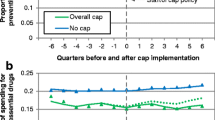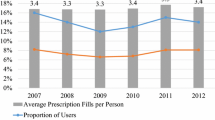Abstract
Background
Little information exists regarding the impact of Medicare Part D on generic drug use.
Objective
To examine changes in the use of generic prescriptions attributable to Part D among a sample of Medicare beneficiaries.
Design, participants, and measurements
Difference-in-difference analysis of pharmacy claims of Part D enrollees and non-enrollees aged 67–79 years from 2005 to 2006. The final sample represented approximately 2.4 million unique subjects. Analyses were conducted separately for major therapeutic classes, limited to subjects filling at least one prescription within the class during 2005 and 2006, and adjusted for subject characteristics, prescription characteristics, socio-demographic characteristics measured through zipcode-linked Census data, baseline differences between Part D and non-Part D enrollees, and secular trends in generic use.
Results
Generic drugs accounted for 58% of total prescriptions. Among the entire group of beneficiaries, there was a trend of increased generic drug use in 13 out of 15 drug classes examined. However, after adjusting for potential confounders, the growth rate of generic drug use was lower among Part D enrollees than among non-enrollees; enrollees were slightly less likely to fill prescriptions for generic drugs vs. brand-name drugs in 2006 compared to 2005 (odds ratio 0.95, 95% confidence interval 0.94–0.95).
Conclusions
Despite secular trends of increased utilization of generic drugs among both Part D enrollees and non-enrollees, the net impact of Part D among these beneficiaries was a modest decrease in the use of generic drugs. This finding, which is consistent with economic theory but contrary to several recent reports, highlights the complexity of assessing the impact of Part D on overall consumer welfare.
Similar content being viewed by others
References
Doherty RB. Assessing the new Medicare prescription drug law. Ann Intern Med. 2004;141:391–5.
Heiss F, McFadden D, Winter J. Who failed to enroll in Medicare Part D, and why? Early results. Health Affairs. 2006;25:w344–54.
Cubanski J, Neuman P. Status report on Medicare Part D enrollment in 2006: analysis of plan-specific market share and coverage. Health Aff. 2006;26:w1–12.
Center for Medicaid and Medicare Services Press Release. Medicare drug plans strong and growing: beneficiaries compared plans and continued to sign up for prescription drug coverage. January 30, 2007. http://www.cms.hhs.gov/apps/media/press_releases.asp (Accessed July 7, 2008).
Pauly MV. Medicare drug coverage and moral hazard. Health Aff. 2004;23:113–22.
Yin W, Basu A, Zhang J, Rabbani A, Meltzer DO, Alexander GC. The impact of the Medicare Part D prescription drug benefit on drug utilization and out-of-pocket costs. Annals of Internal Medicine. 2008;148:169–77.
Generic drug utilization in the Medicare Part D program. Department of Health and Human Services. Office of the Inspector General. November 2007 (OEI-05–07–00130).
Frank RG. The ongoing regulation of generic drugs. N Engl J Med. 2007;357:1993–6.
Hass JS, Phillips KA, Gerstenberger EP, Seger AC. Potential savings from substituting generic drugs for brand-name drugs: Medical Expenditure Panel Survey, 1997–2000. Ann Intern Med. 2005;142:891–7.
National Association of Chain Drug Stores. Available online at http://www.nacds.org/wmspage.cfm?parm1=507 (Accessed on July 7, 2008).
Himmel W, Simmenroth-Nayda A, Niebling W, et al. What do primary care patients think about generic drugs? International Journal of Clinical Pharmacology and Therapeutics. 2005;43:472–9.
Bhat VN. Patent term extension strategies in the pharmaceutical industry. Pharmaceuticals Policy and Law. 2005;6:109–22.
Center for Medicaid and Medicare Services Press Release. Generic drug use on the rise: consumers and payers benefit as more Americans turn to generics as way to save money and improve their health. February 8, 2007. http://www.cms.hhs.gov/apps/media/press_releases.asp (Accessed July 7, 2008).
“Medicare drug plans prompt rise in generic use.” ACP Observer. 2007;27:5.
“Strategies to avoid Medicare’s big hole.” New York Times. November 24, 2007.
Poisal JA, Truffer C, Smith S, et al. Health spending projections through 2016: modest changes obscure Part D’s impact. Health Aff. 2007;26:w242–53.
Stuart B, Singhal P. The stability of Medicaid coverage for low-income dually eligible Medicare beneficiaries. Kaiser Family Foundation Policy Brief. May 2006. Publication #7512.
Geronimus AT, Bound J. Use of census-based aggregate variables to proxy for socioeconomic group: Evidence from national samples. Am J Epidemiol. 1998;148:475–86.
Krieger N. Overcoming the absence of socioeconomic data in medical records: Validation and application of a census-based methodology. Am J Epidemiol. 1992;82:703–10.
Angrist J, Krueger A. “Empirical Strategies in Labor Economics,” Handbook of Labor Economics, Vol. 3, ed. by A. Ashenfelter and D. Card, Amsterdam: Elsevierss; 1999.
Stuart B, Simoni-Wastila L, Baysac F, Shaffer T, Shea D. Coverage and use of prescription drugs in Nursing Homes: implications for the Medicare Modernization Act. Medicare Care. 2006;44:243–9.
Lee M, Kang C. Identification for difference in differences with cross-section and panel data. Economics letters. 2006;92:270–6.
Artz MB, Hadsall RS, Schondelmeyer SW. Impact of generosity level of outpatient prescription drug coverage on prescription drug events and expenditure among older persons. American Journal of Public Health 2002;1257–63.
Clark DO, Von Korff M, Saunders K, Baluch WM, Simon GE. A chronic disease score with empirically derived weights. Med Care. 1995;33:783–95.
Goldman D, Joyce GF, Escarce JJ, et al. Pharmacy benefits and the use of drugs by the chronically ill. JAMA. 2004;291:2344–50.
Alexander GC, Casalino LP, Meltzer DO. Patient-physician communication about out-of-pocket costs. JAMA. 2003;290:953–8.
Braithwaite RS, Rosen AB. Linking cost-sharing to value: an unrivaled yet unrealized public health opportunity. Ann Intern Med. 2007;146:602–5.
Steinberg M, Jones K. Coverage through the ‘doughnut hole’ grows scarcer in 2007. Families USA, November 2006 (Publication #06–107).
Acknowledgements
Dr. Zhang was supported in part by a grant from Merck, Dr. Yin is a Robert Wood Johnson Foundation Health Policy Scholar, and Dr. Alexander has career development awards from the Agency for Healthcare Research and Quality (K08 HS15699–01A1) and the Robert Wood Johnson Physician Faculty Scholars Program. The funding sources had no role in the design and conduct of the study, analysis or interpretation of the data, and preparation or final approval of the manuscript prior to publication.
Conflict of Interest
Dr. Zhang was supported in part by a pilot grant from the University of Chicago Center for Pharmaceutical Policy funded by the Merck Foundation. Dr. Sun previously worked at Walgreens Health Initiatives, is currently employed by Takeda Pharmaceuticals, and has been funded for other projects by grants from Merck, Novartis, BMS, and Sanofi-Aventis. Dr. Alexander has been funded for other projects by the University of Chicago Center for Pharmaceutical Policy funded by the Merck Foundation and by Pfizer.
Author information
Authors and Affiliations
Corresponding author
Rights and permissions
About this article
Cite this article
Zhang, J.X., Yin, W., Sun, S.X. et al. The Impact of the Medicare Part D Prescription Benefit on Generic Drug Use. J GEN INTERN MED 23, 1673–1678 (2008). https://doi.org/10.1007/s11606-008-0742-6
Received:
Revised:
Accepted:
Published:
Issue Date:
DOI: https://doi.org/10.1007/s11606-008-0742-6




